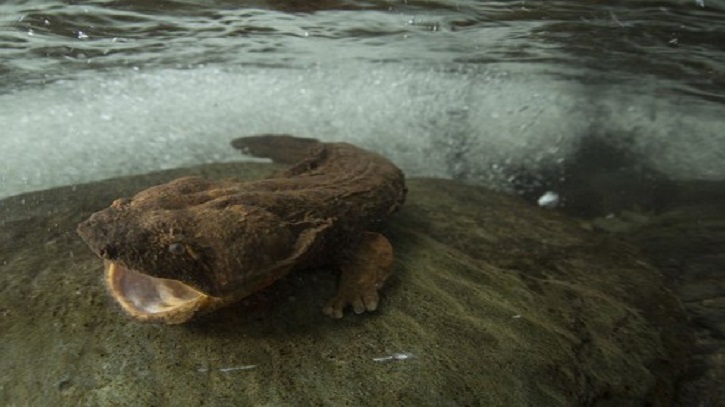
The hellbender, the largest species of salamander in the Americas, is listed as vulnerable on the IUCN Red List, meaning it’s at high risk of extinction in the wild. Yet despite this, the amphibian doesn’t have any federal protection under the U.S. Endangered Species Act (ESA).
That’s set to change, the U.S. Fish and Wildlife Service recently proposed listing the hellbender (Cryptobranchus alleganiensis) as an endangered species under the ESA. If approved, it will open the door to federal funding to help protect the salamander, which can grow to a length of 0.6 meters (2 feet).
Tierra Curry, endangered species coordinator with the Center for Biological Diversity (CBD), told Mongabay by phone that she was so surprised and happy about the proposal that she shed tears of joy. “I wear my heart on my sleeve in the shape of a hellbender,” she wrote in a social media post.
The CBD first sought ESA status for hellbenders in 2010, but it was denied, largely because the salamanders have a huge range across 15 eastern U.S. states, from Georgia to New York. However, they’re successfully reproducing in just 12% of that range, and the core part of it was recently devastated by Hurricane Helene.
The most recent ESA denial was issued by the Trump administration, which argued that zoos and universities were successfully raising them and releasing them back into streams.
“So, they were using population augmentation as a replacement for habitat protection instead of using it in addition to habitat protection, which is how it’s supposed to be used,” Curry said. The CBD challenged that finding in court and won.
The ESA has a good track record of helping endangered species: 99% of those listed don’t go extinct, though they don’t all necessarily rebound, Curry said.
Hellbenders are entirely aquatic and extremely sensitive to pollution, water quality, and sediments in the water, worsened by deforestation along rivers and streams. With protected status, federal money can go toward reforesting riparian areas to keep soil out of the rivers, a move that will improve water quality for many other species as well, Curry said.
The USFWS also recently proposed monarch butterflies for the ESA. Both these proposals are important because of the species’ ranges, Curry said. “The monarch is going to be the widest-ranging proposed species since the bald eagle, and Hellbenders have a 15-state range in the eastern U.S. So many rivers are going to have safeguards now. It’s two huge proposals,” she said.
“Those are both clearly umbrella species for their communities. So, protecting monarchs is going to protect so many other pollinators and especially native bees that don’t get any attention. And the same for hellbenders. It’s going to protect miles and miles of waterways,” she added.





